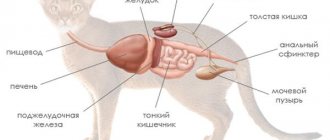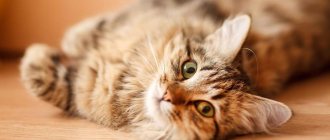MAIN SYMPTOMS OF EAR DISEASES
Recall that the ear organ consists of three parts: the outer ear and ear canal, the middle ear and the inner ear.
The most possible place for infections and parasites to enter is the outer ear and the auditory canal. In the symptomatic manifestations of ear diseases, common signs can be identified. We list them by frequency of occurrence, starting with the most common:
- scratching the ears and head for excessive duration and strength;
- in a calm state, the cat tries to tilt its head as if something inside is bothering it;
- visually noticeable redness and swelling of the outer ear;
- unusual unpleasant odor from the ears;
- when a person tries to touch the ears, the cat shows aggression;
- the presence of discharge from the ears indicates an advanced form of the disease.
Symptomatic manifestations of inflammatory processes in the ears are called otitis media. Otitis media, as a set of symptoms, can occur in any part of the ear. The causes of otitis media are varied.
What to do if a cat has blood in the stool, what the consequences may be. Causes of a mammary tumor in a cat: https://tvoipitomec.com/cats/lechenie/opuhol-molochnoy-zhelezyi-u-koshki.htmll, find out the symptoms.
Video: parasites in cats
Diseases of the external ear and ear canal
For the purposes of this article, we will not consider such painful manifestations of the outer ear as physical trauma to the ear, hematoma, or, for example, an allergy to the sun, which is characteristic of cats living in climates with high levels of ultraviolet radiation.
- Parasitic otitis.
In all other cases, redness and swelling of the pinna and outer ear indicates the presence of parasitic mites in the cat’s ears. There are a sea of species of these ticks: we will not list their biological names.
Note that they are almost invisible, they dig into the thinnest skin of the ears, releasing certain chemicals into the cat’s blood, which leads to skin irritation, itching, and redness. May also be present on the face and paws.
Ticks can easily move from one cat to another, live up to 2-3 weeks in the environment and get on the cat, for example, from the grass.
Diagnosis and identification of mites uses scrapings and smears from the affected skin. All types of mites are effectively removed using insecticides applied to the ears or instilled in the mouth.
The consequences can be problematic, because ticks, having contact with blood, carry infections, sometimes fatal.
- Bacterial otitis.
Bacterial or purulent otitis has a clear manifestation in the form of purulent discharge from the ear and is often a secondary disease, having causes in trauma, ticks or foreign bodies. Thus, the range of bacterial infections can be very wide, including fungal and viral. The pus that appears in the ear canal has an unpleasant odor and makes the cat feel uncomfortable.
Diagnosis is made by analyzing purulent discharge, describing symptoms and external signs. Antibiotics and anti-inflammatory drugs should be used as prescribed by a veterinarian.
- Foreign bodies.
Various plant seeds and other small objects can enter the ear canal due to its partially vertical location.
Typically, a cat can remove foreign objects from the outer ear on its own by vigorously scratching and shaking its head. In veterinary practice, there are methods for non-surgical removal of foreign objects from the ears.
- Tumors of the ear canal.
Ear canal tumors are rare and common in older cats. Often tumors are accompanied by some kind of secondary infection, which is the main visible symptom.
If a tumor is suspected, a series of tests, including a biopsy, are performed to determine the quality and characteristics of the tumor. Surgery is often indicated. To access the horizontal canal of the ear, the surgeon performs a resection of the vertical canal by opening its outer wall.
The first steps to take when there is blood in a cat’s urine, let’s find the root of the problem. Here you will be helped to remove fleas from a cat, with a detailed explanation.
Signs of pregnancy in cats, how to identify them and what to do.
General symptoms of fungal infections
After susceptible areas of the animal’s body are infested with fungal spores, the pathological process begins. Fungal microorganisms feed on beneficial substances on the cat’s body, releasing toxic and enzymatic substances in response.
Fungal diseases in cats are diagnosed by the gradual destruction of the upper layers of the dermis with the spread of inflammation on the surface. In the absence of proper therapy, the pathology affects the deep layers of the dermis, hair follicles are damaged and the structure of the coat is disrupted. At the location of the lesion, bald spots with scales, wounds and crusts form.
Symptoms of fungus in cats are characterized by the following features:
- hair breakage and further hair loss at the site of the lesion;
- the appearance of areas on the skin without hair with flaky scales (usually in the neck, ears and front paws);
- anxiety of the pet (the animal actively shakes its head and experiences itching);
- the appearance of a repulsive odor and discharge from the ear;
- plaque on the ears in the form of small brown-red dots;
- formations look like subcutaneous tubercles and peculiar nodules on the skin;
- runny nose and sneezing, with blood;
- formation of polyps in the nasal passages.
If left untreated, the symptoms become more complicated as a result of the penetration of the pathological process into the deep layers of the dermis.
Inflammatory processes of a purulent-necrotic nature occur there. The surface of the damaged skin is covered with scabs, purulent crusts, and periodically protruding exudate. Other serious complications of fungal infection include inflammation in the pulmonary structures, weight loss, development of anemia, and dyspeptic disorders.
With a weakened immune system in a young kitten, the pathological process develops so quickly that it can cause death.
Types of fungal infection and its consequences
The causative agents of the disease in pets are yeasts or molds. In cats, ear inflammation is caused by a yeast fungus called Malassezia pachydermatis. In addition to the ears, it affects the mucous membranes and skin, causing severe itching. The cat scratches the site of infection, which provokes the addition of a bacterial infection.
Aspergillus fungus is a mold that causes damage to the skin, which can spread to the ear. Dangerous for mucous membranes, nervous system, and gastrointestinal tract.
Very often, cat owners confuse a fungal infection with a mite, or decide that the animal has ordinary otitis media. If the problem is not accurately identified, proper treatment does not begin immediately. This can lead to serious consequences: swelling of the brain, inflammation of the eyes, hearing loss, complete deafness.
Treatment of cats with ear pathologies
Considering the variety of ear pathologies and their different etiologies, it is easy to understand that the treatment of a cat will directly depend on the root cause of the disease:
Let's start with otodectosis, since it occurs in almost every second cat. And, by the way, there are no problems with his treatment either. In any veterinary pharmacy you can find dozens of types of drops. Among them are: Stronghold, “Dana”, “Bars”, Otovedin, Tsipam, Aurikan and many others. As an aid, you can use 3% hydrogen peroxide and a strong infusion of green tea. They are good for cleaning the ears before administering the main medicine.
As for otitis media, it is more complicated. The ear canal must be cleaned daily with the same peroxide, green tea and/or salicylic alcohol. In severe cases, ear rinsing with antiseptic compounds is also prescribed. Broad-spectrum antibiotics are used to destroy pathogenic microflora. At the moment, it is advisable to use drugs from the group of cephalosporins.
The worst situation is with fungal pathologies. For their treatment, the following are used: Amphotericin B, Flucytosine, Econazole and Clotrimazole. Special antibiotics from the griseofulvin group have proven themselves to be effective.
Treatment and prevention
To quickly get rid of the problem, it is necessary to eliminate the causes that provoked the onset of the disease and begin to properly treat the fungus in the cat’s ears. It is treated, like fungal infections of other organs, with antifungal drugs.
© shutterstock
Drugs for treatment
Antifungal drugs are prescribed only by a doctor. Flucytosine and amphotericin B are infusion solutions that give good results. Ketoconazole and griseofulvin tablets are prescribed internally - the doctor will prescribe the dosage and frequency of administration. In addition to solutions and tablets, antifungal ointments and liniments (Econazole, Sanoderm) are prescribed, which are placed in the ears.
Causes of otitis media in cats
The hearing organ of representatives of the cat family consists of three sections:
The cat's ear consists of three sections - outer, middle and inner.
Depending on the part in which the inflammatory process occurs, otitis media are classified. External or otitis media, if detected early and treated correctly, can be cured quite quickly. Deep, or otitis of the inner ear, is considered one of the most dangerous pathologies, which is fraught with serious consequences and complications.
An animal of any age can get otitis media. The reasons leading to the occurrence and development of the disease can be different:
- Parasites. The vital activity of fleas and ticks leads to the development of otitis media quite often. The inflammatory process begins in the outer ear and, if left untreated, quickly moves deeper.
- Allergy. Allergic otitis media can be caused by taking some food or medication. The itching that accompanies the disease forces the animal to constantly scratch problem areas. The resulting microtraumas become breeding grounds for bacteria.
- New growths or ingress of foreign objects. A tumor or any object lodged in the ear prevents the release of wax and also irritates the internal receptors. The resulting itching makes the pet feel restless and constantly scratch, which provokes inflammation.
- Injuries. Scratches and other microtraumas not treated with antiseptics and wound-healing preparations can provoke inflammation.
- Fungi. Otitis media can develop against the background of fungal infections of the skin.
- Low level of immunity. If the body is not sufficiently protected, any disease or injury can trigger inflammation.
- Hypothermia or water ingress. Drafts and moisture can cause serious harm to the health of the animal. Water that gets inside the ear becomes an excellent breeding ground for bacteria. Hypothermia weakens the body's defenses, as a result of which it cannot fight pathogenic microflora, which contributes to the development of inflammation.
- Hormonal imbalances. Any deviation in hormone levels can trigger the development of otitis media.
- Autoimmune pathologies. In the presence of such a disease, the immune system mistakes the animal's native tissues as foreign and tries to get rid of them. Against this background, inflammation develops.
- Insufficient hygiene. Some animals produce excess earwax. Untimely removal of it contributes to the accumulation and development of pathogenic flora.
Yeast infections and bacteria complicate the course of otitis media. For them, a favorable environment is the mucous membrane and skin, the integrity of which is compromised.
Complications of the external type of the disease do not always lead to the development of otitis media and internal otitis. There are a number of reasons that directly provoke inflammatory processes in deeper sections. These include:
- injuries to the temporal part of the skull;
- perforation of the membrane due to various external factors;
- tumor growths.
An advanced form of pathology - purulent otitis - leads to rupture of the membrane. Through the resulting hole, pus enters the head, leading to inflammation of the brain and deafness.
Treatment of fungus in the ears of a cat
In order to help you choose a treatment strategy for a sick cat, you need to know which fungus caused the disease. Was the research carried out by a veterinary laboratory? If the inner surface and ear canal of one or both ears are affected, then most likely it is Malassezia otitis media.
However, it is possible that your pet has affected skin on the outside of the ear, which is often the case with ringworm.
Treatment for these two mycoses is not the same.
In Malassezia otitis, as a rule, fungi play a supporting role, and the primary pathogens are pathogenic bacteria. Therefore, in the treatment of this disease, complex preparations containing antibiotics and antifungals are used:
- Aurizon (marbofloxacin, clotrimazole, dexamethasone acetate);
- Mometamax (gentamicin sulfate, mometasone fuorate, clotrimazole);
- Isotik (hydrocortisone aceponate, gentamicin sulfate, miconazole nitrate);
- Posatex (orbifloxacin, mometasone, posaconazole);
- Otonazole (miconazole nitrate, prednisolone acetate, polymyxin B-sulfate).
Reducing the severity of the inflammatory process and accelerating the healing of ear lesions is facilitated by treating them with astringents (isopropyl alcohol, boric, benzoic, salicylic acids, aluminum acetate, silicone dioxide). In cases where otitis is accompanied by skin itching, glucocorticosteroid drugs (prednisolone, dexamethasone, etc.) are additionally used (usually locally, sometimes orally or by injection) if there are no contraindications for such treatment.
It is very important to regularly clean the ears - this procedure for Malassezia otitis media gives no less effect than the use of specific drugs.
To remove waxy ear secretions, ceruminolytics (vegetable or mineral oils and solvents, for example, propylene glycol, glycerin, squalene, hydroxytoluene, cocamidopropyl betaine) are used. Many ear cleaning products (Earcleaner) include surfactants (sodium dioctyl sulfosuccinate, calcium sulfosuccinate, etc.), emulsifying components of ear secretions.
Ringworm is treated by cauterization (no more than once a week) with an alcohol solution of iodine, daily treatments with ointments/creams/gels/sprays with antifungal drugs (clotrimazole, lamisil, etc.), as well as 2-3 times vaccination.
It is very important to regularly clean the ears - this procedure for Malassezia otitis media gives no less effect than the use of specific drugs.
Lymphextravasate
The reasons for this phenomenon are similar to those described above - strong blows, injuries, cat “fights” during the March spree, etc. Lymph moving through the lymphatic vessels penetrates into nearby tissues, resulting in the formation of a bubble. Sometimes, in addition to lymph, blood also accumulates in the “pocket,” turning the contents brown.
The main difference between lymphatic extravasate and inflammatory pathologies is the absence of elevated temperature. When palpated, the swelling will be cool or slightly warm. It will be difficult to help the cat at home; surgical intervention will be required.
To begin with, the animal is given sedatives to relax it as much as possible and relieve nervous tension. Next, the bubble is pierced with a special needle and the accumulated liquid is removed. The skin is treated with an alcohol solution (usually iodine) and a sterile dressing is applied.
If the affected area is too large, then the operation is performed under general anesthesia. If there are detached tissues, they are excised, after which sutures are applied. If the doctor has suspicions about possible suppuration of the wound, drainage with an antiseptic is placed in the cavity.
General symptoms of ear diseases in cats
The main signs of ear diseases in cats are easy for owners to identify; for this, it is necessary to regularly examine the animal.
- painful sensations in animals when palpating the ears;
- scratching the ear area and the ears themselves until bloody wounds appear;
- the animal often shakes its head and touches its ears with its paws;
- the pet has an unpleasant odor coming from the ears;
- the swelling of the outer part of the auricle is visually determined;
- During hygiene procedures, discharge from the ears is observed.
Read here Pyometra in a cat - causes of the disease, symptoms, treatment and possible complications (120 photos)
To make a timely diagnosis and develop an effective treatment plan, hygiene procedures should be carried out regularly.
Characteristic signs of the disease
The following symptoms will indicate that your cat has a fungus in the ear::
- the cat often scratches its ears and constantly shakes its head;
- fluid is released from the ears and there is an unpleasant odor;
- ears swell and redness appears;
- peeling of the skin appears;
- The animal is restless and does not eat well.
© shutterstock
If there is at least one of these signs, it is necessary to examine the cat's ears. Be sure to show the animal to a veterinarian if nothing can be identified on your own, but the symptoms remain .
Causes of ear fungus
Once again, the fungus will not “break through” the immunity of a healthy cat. In cases of fungal pathologies, you always need to think about what exactly was the root cause:
Finally, we should not forget about long-term use of antibiotics or corticosteroids, but we have already written about them above.
Foreign bodies and injuries. The stubble of old (last year's) grass is especially dangerous. Firstly, it perfectly injures the ears on its own. Secondly, old grass particles contain a huge number of fungal spores. The combination of trauma and a foreign body = almost unambiguous development of a bacterial or fungal (or fungal immediately after a bacterial) infection. If your cat regularly walks outside, check the condition of his ears just as regularly.
pathology. Deficiencies or excesses of various hormones are a very dangerous cause of fungal pathologies. Thyroid hormones, glucocorticoids synthesized by the adrenal glands and sex hormones - all of them not only directly affect fungal ear infections (more precisely, they increase the likelihood of their occurrence), but also on the health of the entire skin.
Diagnostics
Problems often arise with making an accurate diagnosis. It is impossible to determine by eye what exactly caused the infection - it is fungi, or bacteria, or just an allergy (it may well turn out that all three factors are to blame). Simply put, we need high-quality diagnostic studies.
Veterinarians often use an otoscope, which is necessary to visually assess the condition of not only the ear canals, but also the eardrums. It can be used to identify tumors, foreign bodies, and fungal growths. Smears and scrapings are taken (and in difficult cases a biopsy is done), the materials of which are used for microscopy, cytology, seeding on nutrient media, etc.
A careful history and complete examination of the animal can help determine what exactly was the “trigger” for the fungal infection. In doubtful cases, as well as when the clinic is insufficiently equipped, the diagnosis can be made based on the result of treatment. So, if there is no particular positive dynamics after the prescription of broad-spectrum antibiotics, one can confidently suspect the presence of a fungal pathology.
Symptoms and types of fungus in cats
Excessive grooming of the cat: frequent bathing with shampoo, constant cleaning of the ears with cotton swabs, and other grooming procedures contribute to the development of fungi.
Fungus in cats manifests itself in various symptoms.
Some of them can be detected immediately, while others only after laboratory tests.
If you suspect this disease, it is necessary to isolate the cat from contact with other animals until the diagnostic results are obtained.
If you suspect a fungus in cats, its symptoms should be as follows:
- frequent and prolonged combing of a certain area;
- ear fungus is characterized by frequent scratching and pressing of the ears, shaking of the head;
- depressed state;
- refusal to eat;
- cough.
There are 2 types of fungus in cat breeds:
- Formed on the skin and mucous membranes of an animal: ringworm and yeast stomatitis.
- Systemic fungi that affect the internal organs of the cat.
Many people know first-hand what ringworm looks like. Its distinctive features are a rounded area of skin without hair, the edges of which have a bright red color.
With yeast stomatitis, increased salivation appears, an unpleasant odor from the oral cavity, the color of the mucous membrane changes, and bleeding wounds appear in the mouth.
Systemic forms of the fungus are very rare in cats.
These include the following types:
- Cryptococcosis. It is formed by a yeast-like fungus found in the soil layer of the earth and in bird droppings.
Characterized by coughing, sneezing, difficulty breathing, bloody discharge from the nose, and lumps under the skin.
In the advanced form, the nervous system is affected, leading to loss of vision and seizures.
If left untreated, it can lead to meningitis and death of the cat. This is one of the most difficult fungal diseases to treat. Histoplasmosis. It is very dangerous, since the symptoms of infection are similar to those of other diseases, so it can be difficult to immediately make a correct diagnosis.
Appetite is disrupted, accompanied by weight loss, body temperature rises, weakness and apathy occur, and the eyes and skin are affected. Treatment must be carried out in the early stages of the disease.
Blastomycosis. They affect the respiratory system, skin, eyes and brain. Dogs and humans can also get these diseases.
Actinomycosis. It is caused by a radiant type of fungus that affects the mouth, neck, chin, area around the nose and lips, groin, and chest.
When fungus forms on the face and neck, a slight rise in temperature occurs, and the movement of the jaw and chewing muscles is limited.
When the chest and abdominal area are affected, a high temperature, expectorant cough with discharge, and loss of strength develop. Ear fungus. The most common infection, which is very easy to determine by observing the cat’s behavior.
The animal constantly and for a long time scratches its ear with its paw, experiencing pain, and shakes its head or turns to the sides. A large amount of wax forms in the ears.
If left untreated, the fungus enters the middle ear, causing meningitis, and can lead to the death of the animal.
Mycetoma. It affects the skin and tissue underneath it, sometimes the skeletal system. Its granules are localized on the toes and near the nails, where its new growths appear and grow.
Candidiasis. Affects the skin and mucous membranes of the mouth. Formed in the form of a white coating or scaly wounds.
Appears during prolonged treatment of an animal with antibiotics, intestinal tract infections, pulmonary diseases. Mycosis. This infection affects cats with reduced immunity. Main symptoms: redness of the skin, spots on the abdomen, ears and genitals.
Hair loss and dandruff occur.
Malassezia. Manifested by severe baldness.
Important! Many fungal diseases do not cause any special problems for the cat, but greatly reduce the immune system. Because of this, the cat becomes susceptible to dangerous viruses.
Is fungus dangerous for humans?
The fungus is not often transmitted to humans, but it does happen, and it is best to protect yourself from the disease.
We recommend reading: Worms in an Old Cat
Fungal spores are found on the animal’s fur, which it picks up on the street, from other animals, as well as from humans, which it can easily bring into the home.
Therefore, maintaining hygiene is of particular importance.
If fungus is detected in your cat, an immediate visit to the veterinarian is necessary, who will give you recommendations on how to protect yourself from infection.
If you have been bitten or scratched with its claws by an unfamiliar cat, you should immediately contact a medical facility in order to eliminate an accidental infection with a fungus.
Look at the video for more nuances about this disease:
Thanks for the comprehensive information. If you find out the type of fungus, then you can use this information. Often veterinarians are very illiterate and it turns out too late. Animals often die because of their mistakes. This information makes it possible to monitor the correct treatment.
Systemic forms of the fungus are very rare in cats.
Diagnosis of otitis media in cats
It is better not to engage in independent treatment and diagnosis, as this can significantly harm your four-legged pet. When visiting a veterinary clinic, the doctor will perform a number of manipulations to determine the correct diagnosis:
- visual examination of the ear canal using an otoscope;
- laboratory examination of purulent discharge from the ear;
- blood analysis;
- magnetic resonance and computed tomography of the cat;
- endoscopy of the ear and biopsy of secretions.
The listed list of procedures is not mandatory. Most often, it is enough for a veterinarian to examine the sore ear to determine the diagnosis.
Sometimes there are no exudative accumulations in the animal’s ear canals, and the ear appears healthy at first glance
In such situations, the doctor pays attention to the cat's eyeballs. If they are of different sizes, and the pupils react to light differently, this indicates that the pet has Horner's syndrome - a disorder of the extraocular muscles.
Such changes may occur due to otitis interna in cats.
As ear disease worsens, vestibular abnormalities can often be observed. Vestibular syndrome is accompanied by imbalance of the head and unstable gait. When walking, the cat may fall to the side. Sometimes drooling, asymmetry of the paired facial organs, and rapid breathing appear.
Treatment of ear fungus with folk remedies
Traditional treatment is used in conjunction with traditional treatment. This treatment is more effective and will quickly get rid of the fungus.
Onion juice
Onion juice is one of the popular folk methods for treating fungus. To do this, use squeezed onion juice. 5 drops of juice are instilled into the sore ear at night. It is worth taking into account that this treatment cannot be used for a long time.
Hydrogen peroxide
- You need to lie on the side of the healthy ear;
- instill 3-4 drops of hydrogen peroxide into the sore ear;
- lie in this position for 5-10 minutes;
- then thoroughly rinse the outer ear canal with clean warm water;
- wipe the ear with cotton swabs or a cotton swab.
Walnut oil
After treatment with hydrogen peroxide has been performed, walnut oil is used. To do this, you need to lie on the side of the healthy ear. Then 1 drop of oil is instilled into the sore ear. Gradually the number of drops increases to 4.
In parallel with the main treatment, be sure to pay attention to the state of your immunity, because a fungal disease already indicates that a malfunction has occurred in your body. Try to be in the fresh air more often and strengthen your immune system with vitamins.
- if the infection was caused by a mold fungus, Terbinafil, Nitrofungin, and Naftifin are prescribed.
- If the infection was caused by a yeast fungus, Fluconazole, Econazole, and Pimafucin are prescribed.
Symptoms of the disease
Otitis media in cats is accompanied by severe itching; the animal scratches the sore spot and tilts its head. Symptoms such as:
- redness of the ear and parotid area;
- hair loss;
- violation of the integrity of the skin, its thickening and roughening;
- discharge from the ear;
- copious discharge of pus (if the eardrum is damaged);
- ulcers inside the ear;
- crust formation;
- in the case of a purulent form of the disease, body temperature rises;
- when the inner ear becomes inflamed, coordination of movements is impaired, the cat spins in place and falls;
- the animal becomes lethargic, appetite worsens, vomiting begins;
- in severe cases, paralysis of the facial nerve may occur - a distortion of the lip will be observed on the side of the affected ear.
When the last four symptoms appear, the cat must be immediately taken to the veterinarian, as a serious complication may develop - meningoencephalitis.
Discharge from the ear that appears with otitis media varies. By their appearance, you can determine the type of infection:
- abundant, thick dark brown purulent discharge indicates infection with fungi of the genus Malassezia or parasitic mites, which are the causative agent of ear scabies (otodectosis);
- liquid brownish - indicate the staphylococcal or streptococcal nature of the disease;
- Strong-smelling yellowish-greenish discharge indicates the presence of infection with Pseudomonas aeruginosa or pathogenic enterobacteria of the genus Proteus.
When you press on the base of the cat's ear, you can hear a characteristic squelching sound. With a prolonged course of the inflammatory process, the ear canal narrows, and benign formations appear in the affected areas.
Possible reasons
Fungal spores surround animals everywhere. The fungus is present on the skin and fur of a healthy cat. As soon as it finds favorable conditions, the active growth of fungal colonies begins. A cat's ear is an ideal place for the rapid development of fungus: it is warm, humid, and has a lot of wrinkles.
The main factors that provoke fungal ear infections in cats:
Our readers successfully use Papilite to treat papillomas. Seeing how popular this product is, we decided to bring it to your attention. Read more here...
- weakening of the immune system;
- susceptibility to yeast fungi from birth;
- long-term non-healing wounds;
- frequent ear hygiene;
- addition of a secondary infection;
- chronic diseases;
- poor nutrition.
Cats should not be bathed or have their ears cleaned frequently, as the natural microflora of the skin is washed away. After all, beneficial bacteria live on their skin, which protect pets from diseases. A decrease in their number leads to a decrease in local immunity.
Anatomy of the ears of cats and cats
If we consider the picture as a whole, we can say that the appearance of nail fungus in cats (and not only it) occurs when the pet has physical contact with other representatives of its species.
This is especially true in rainy weather or in a house where there is a constant humid environment. In addition, you should be wary of minor injuries, diaper rash, etc.
The following factors can lead to the appearance of fungus:
- A young and fragile body;
- The period of lambing in a cat, when the body’s defense systems weaken;
- Decreased immunity due to the activity of a dangerous virus;
- Poor feeding;
- Carrying out immunosuppressive therapy;
- The influence of other serious diseases such as diabetes.
The ear is the organ of hearing and balance. It consists of outer, middle and inner.
The outer ear includes the pinna (the visible part of cartilage covered by skin, fur, or hair) and the ear canal. The ear canals of cats and kittens are deeper and more conical than those of humans. This deeper canal is prone to the accumulation of dirt and wax, leading to inflammation and secondary infections.
Cats' hearing is many times more sensitive than humans'.
The middle consists of the eardrum and an air-filled chamber that contains 3 tiny bones, 2 muscles, the oval window and the eustachian tube.
Anatomy of a cat's ear
Etiology and routes of infection
The development of fungal diseases in cats is caused by a wide variety of spore-forming and parasitic pathogens. In most cases, animals become infected from each other through contact. However, pets that are isolated from the street and never leave the apartment run the risk of encountering fungal spores that have taken a liking to their owners’ outdoor shoes and clothes. “Blooming” is favored by rainy weather and high humidity in the room where the animal lives.
Skin infection occurs through microtrauma, scratching, and diaper rash. The development of pathology is promoted by:
- young age of the animal;
- weakening of the body's defenses during pregnancy and lactation;
- decreased immunity as a result of viral infection;
- insufficient or unhealthy nutrition;
- carrying out immunosuppressive therapy;
- some chronic diseases (diabetes mellitus, hypothyroidism).
Reproducing with the help of conidia (spores), dermatophytes form mycelium (mycelium), growing over the surface of the skin and penetrating into the inner layers.
Some fungal infections may be asymptomatic and are detected only after signs are detected in the hosts. Children are most often infected.
Fungus prevention
Prevention of fungal infections in cats is very important, as it allows you to protect your pet with high efficiency.
First of all, to prevent the onset of the disease, preventive vaccinations should be used, which are carried out once a year.
Also, to maintain the health of the animal, it is important to provide it with adequate nutrition, sufficient physical activity and high-quality skin care with regular washing at least once every 3 months and no more than once every 2 months, unless otherwise indicated.
Since any cat can become infected with a fungus, even one living only in an apartment, it would be a good idea to regularly inspect the animal’s body.
to identify the beginning of the formation of bald spots and weeping wounds. Your cat's ears should be cleaned at least once every 10 days.
Many breeders are so accustomed to their cat constantly rubbing and scratching his ears that they take this behavior for granted. But that's not true. Itching in this area can be a sign of many diseases, some of which are very dangerous, if not for life, then certainly for the health of the animal - for sure. For example, ear fungus in cats can lead to such symptoms.
Practicing veterinarians have long concluded that fungal pathologies of cat ears are most often caused by one of two types of pathogens: either Malassezia pachydermatis
, or (which is much less common)
Candida albicans
. Accordingly, the disease is called malassezia or candidiasis.
Let's look at Malassezia pachydermatis first. This is a very nonspecific pathogen in every sense of the word. In fact, Malassezia does not even belong to the “classical” mushrooms, but to yeast microorganisms.
But that’s not what makes it special. The fact is that this yeast fungus under normal conditions not only does not cause any diseases, but is also a real symbiont.
Its layer covers the surface of the skin of even healthy animals, preventing other microflora from penetrating into its thickness. Accordingly, it is a natural protective cover. But sometimes it happens that harmless yeast “mutates”, turning into a causative agent of inflammatory pathology of fungal etiology.
The reasons for this are quite simple:
strong and long-term, long-term use of antibiotics and/or anti-inflammatory corticosteroids at home, without veterinarian supervision. These drugs, being very useful and even indispensable in the fight against infectious diseases, can play a bad joke on the animal. It is for this reason that they are recommended either to be changed or to take breaks from use.
As for Candida albicans, it is quite a pathogenic fungus, without any symbiotic “habits”.
True, it rarely affects the ears. Candidiasis is much more typical for the mucous membranes of the respiratory organs. However, against the background of extremely long-term use of antibacterial agents and the same anti-inflammatory corticosteroids, ear diseases develop quite often.
Diagnosis and treatment
Treatment of fungus in cats depends on the type of infection, the size of the affected area, and the general condition of the animal’s body.
General treatment methods include:
- the use of antifungal shampoos;
- applying topical antifungal agents to infected areas;
- taking antihistamines if there is itching;
- use of a specialized collar to limit scratching;
- oral or injection antifungal medications.
| Type of disease | Type of medicine | Name |
| skin fungus | tablets, powders | ketoconazole, moxicillin, terbinafine |
| ointments | clotrimazole, yam, tar ointment | |
| shampoos | nizoral, sebozol | |
| injections | microderm, polyvac, dermicocide | |
| ear fungus | drops | aurizon, oricin, posatex |
| pills | ketoconazole, griseofulvin | |
| ointments | Econazole, Sanoderm | |
| claw fungus | pills | terbinafine, fluconazole, lamisil |
| ointments | clotrimazole | |
| bath solution | enilconazole, chlorhexidine, thiabendazole | |
| eye fungus | drops | tsiprolet, chloramphenicol, leopard |
| ointments | tetracycline |
To treat skin fungus using traditional methods, you can use an ointment made from honey and fish oil. Mix the ingredients to a creamy consistency and lubricate the affected areas 4 times a day. Another option is to use a mixture of olive oil and lemon juice in equal proportions. Soak cotton wool in the heated mixture and wipe the affected areas 4 times a day. Kerosene can be used for a one-time treatment of the skin when treating bald areas of the skin.
Onion juice is used to treat ear fungus using traditional medicine. Half the onion is grated, and the juice from the resulting mass is dripped into the ear infected with the fungus, 5 drops at night for 5 days.
Treatment of claw fungus in a traditional way involves using a solution of apple cider vinegar, hydrogen peroxide in warm water in the following proportions: 600 ml of warm water, 50 ml of peroxide and 50 ml of apple cider vinegar. The cat's paw infected with the fungus is dipped into the resulting solution and held for 30 seconds, then pulled out and allowed to dry.
To treat eye fungus in cats, it is possible to use chamomile infusion. Brew a teaspoon of chamomile with half a glass of boiling water and let it brew, cool to room temperature and drip 2 drops 5 times a day. You can also instill willow decoction. Cut off the ends of branches without leaves. Dry it and break it into several pieces, put it in boiling water, boil and leave to infuse for 20 minutes, then strain and cool. Apply 2 drops 3 times a day.
Fungus in cats - symptoms and treatment methods
The skin is the largest organ in area and performs a large number of functions. But the main function is to protect the body from various harmful factors, including fungal infections.
It is important to know the main reasons for the development of fungus in cats, as well as how to eliminate it. Pedigree pets, as well as animals with reduced body defenses (kittens and pregnant cats, as well as pets who have suffered a serious illness) are at risk for fungal infections.
Fungal microorganisms are always located on the pet’s skin, but the barrier function of the skin prevents the spread of the disease. And only with a sharp decrease in immunity does the pathology spread to certain areas of the skin, affecting the animal’s body.
Fungus in cats is a kind of generalization of a whole group of pathological processes provoked by fungi.
Thus, there are a number of fungal microorganisms that cause dangerous changes in the internal organs of the animal, on the skin or internal layers.
Parasites located on the outer integument lead to the fact that the upper layer of the epidermis begins to peel off, the pet's fur undergoes changes, becomes dull and emits a repulsive odor. In the absence of timely assistance, extensive wound surfaces with severe itching appear on the animal’s skin.
All this leads to decreased immunity, disturbances in the animal’s mental state, and weight loss.
It is important to note that dermatomycosis poses a certain danger for the owner, especially some types of pathology
Therefore, it is extremely important to promptly show the cat to a veterinarian to exclude or confirm the disease. In the case of diagnosed dermatomycosis, the pet is prescribed a long-term therapeutic course, requiring the owner to follow all the doctor’s recommendations
In the case of diagnosed dermatomycosis, the pet is prescribed a long-term therapeutic course, requiring the owner to follow all the doctor’s recommendations.
Symptoms and treatment of fungus in the ear
Fungus is a rather serious disease. In some situations, it is much more complicated than other inflammatory processes in the ear, for example, otitis media. Let's look at the main symptoms and methods of treating fungus in the ear.
Symptoms of ear fungus
The main symptoms include the following:
- ear congestion;
- constant itching in the ear;
- systematic formation of ear plugs;
- unnatural discharge from the ear;
- general dizziness and headaches;
- general hearing loss.
As mentioned above, the fungus spreads quite quickly, which can lead to damage to the auditory nerve. As a result, partial hearing loss may occur. If you ignore the symptoms of the disease and delay the main treatment, the disease can become chronic, which cannot be completely cured.
How to cure ear fungus
First of all, treatment of fungus in the ear begins with eliminating the cause that caused the development of the fungus. For example, if the formation of fungus was caused by taking medications (antibiotics, hormonal drugs), then stop taking them. If a fungal disease occurs against the background of decreased immunity, vitamin therapy and antihistamines are prescribed.
Maintaining ear hygiene is a prerequisite for effective treatment.
Ear hygiene can be carried out using a special solution of glycerin, as well as plain water.
Then the ENT specialist prescribes antimycotic drugs. Various drugs are prescribed, depending on the causative agent of the infection:
- if the infection was caused by a mold fungus, Terbinafil, Nitrofungin, and Naftifin are prescribed.
- If the infection was caused by a yeast fungus, Fluconazole, Econazole, and Pimafucin are prescribed.
These medications are used as follows: antifungal drops in the ears or the solution is applied to a cotton swab. This flagellum is then inserted into the affected ear. The flagellum should be kept for 5-10 minutes. Number of repetitions: 3-4 times a day. The full course of treatment is 3 weeks.
We recommend reading: Biseptol in the Treatment of Toxoplasma in Cats
In some cases, these drugs do not give the desired results. How to cure ear fungus in this case? In this case, the ENT doctor prescribes antifungal tablets. They are prescribed strictly by your doctor, as they have a number of contraindications. These drugs can disrupt the intestinal microflora, so it is recommended to use Bifikol, Narine, and Gastofarm in parallel.
Taking antifungal tablets










